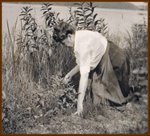Under the Arbor is the column I write for the Gene Stratton-Porter Memorial Society's newsletter. Here is the latest article on phlox.
Enjoy the sweet perfume of clusters of white, pink or purple blossoms as you stroll through the western beds of the tame garden from mid-summer through fall. You may notice a tiger swallowtail or hummingbird on one of the blossoms. What is that plant? It is a native plant, an heirloom plant, and one of Gene’s original plants in her Tame Garden. It is Phlox paniculata, commonly called garden phlox, summer phlox, fall phlox or tall phlox, and its popularity in modern gardens is increasing.
Native Plant
There are more than sixty species of phlox. All are North American natives except one found in Siberia. The wild form of Phlox paniculata is native from New York to Georgia and west to Arkansas and Illinois. It occurs on rich, moist soils along stream banks and in open woods. The great naturalist and plant explorer John Bartram sent Phlox paniculata to England in the early 1700s. Their showy, fragrant flowers quickly became a hit throughout Europe and by the mid 1800s they were available in the nursery trade. They didn't re-cross the Atlantic until Victorian times.
Heirloom Plant
The native phlox, bred in England for a wide range of flower colors, improved habit, and increased resistance to diseases, quickly became a favorite garden plant in its native land and you can find it in many old gardens. (See picture of Gene’s garden.) It also held the romantic meaning of "our souls are united."
Pollinators
The interdependence between plants and pollinators, such as butterflies, moths, bees and hummingbirds, is mutually beneficial. A pollinated plant is able to reproduce and the pollinator has a food source. Phlox paniculata is a nectar source for the black swallowtail and zebra swallowtail, but its lure isn’t restricted to daytime pollinators. A Hawkmoth may hover next to its blossoms from late afternoon to dusk; in fact, phlox is listed as an adult nectar source. In the evening, as the sweet scent of phlox drifts across the garden, night moths may be drawn to the flowers, especially those with white blossoms.
Phlox in Your Garden
Phlox paniculata provides great garden color and fragrance from July through September, filling that gap between the bounty of the early summer bloomers and the fall bloomers. It is often called "the backbone of the summer border" by landscape designers. It can be used in a formal garden, a cottage garden or in a naturalized design.
Phlox are excellent cut flowers with a long vase life. Many of the smaller cultivars make nice container or patio pots.
There are hundreds of cultivars hybridized and selected for flower color, size and fragrance. The plant height when blooming varies widely by the cultivar and ranges from 15 to 48 inches.
Phlox paniculata is not a perfect plant. Powdery mildew is often a problem. The mildew can be reduced if you plant so there is good air circulation, if the plants are not crowded, and if you water in the early morning so the foliage can dry. Many new cultivars claim resistance to powdery mildew, but several studies have shown some heirloom cultivars have better resistance.
We often have Phlox paniculata for sale on the plant rack near the Carriage House. Why don’t you take one of “Gene’s plants” home and try it in your garden?

No comments:
Post a Comment